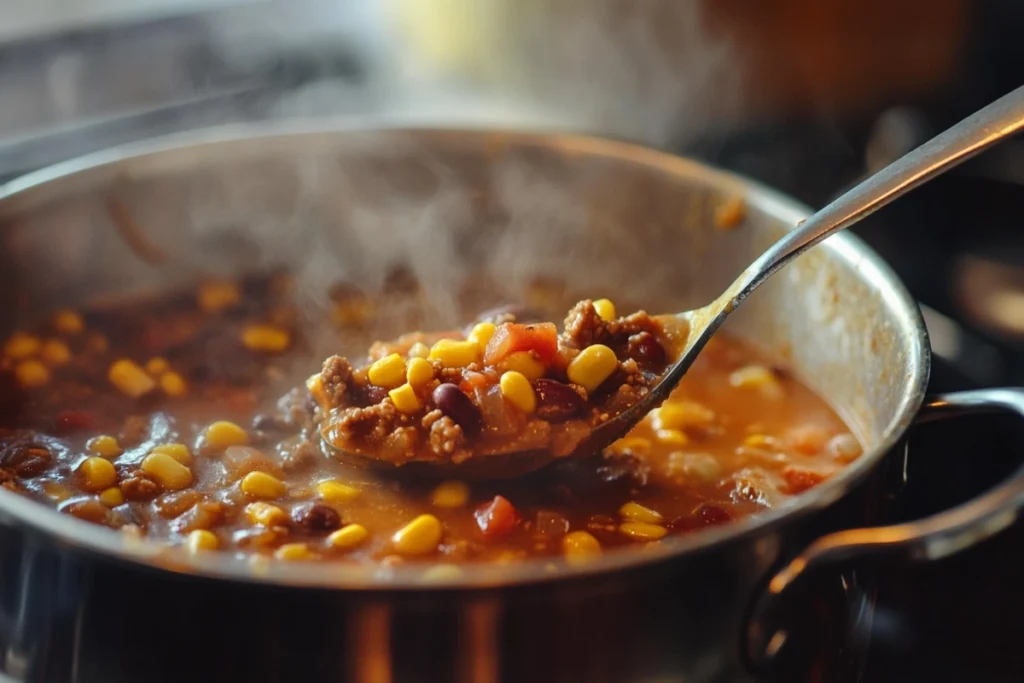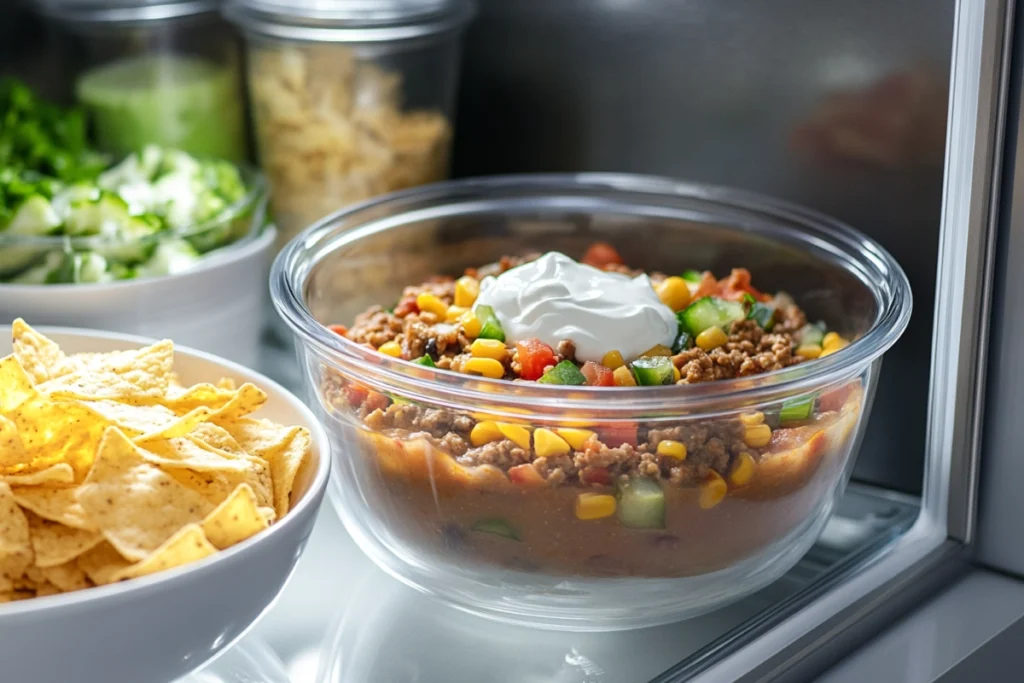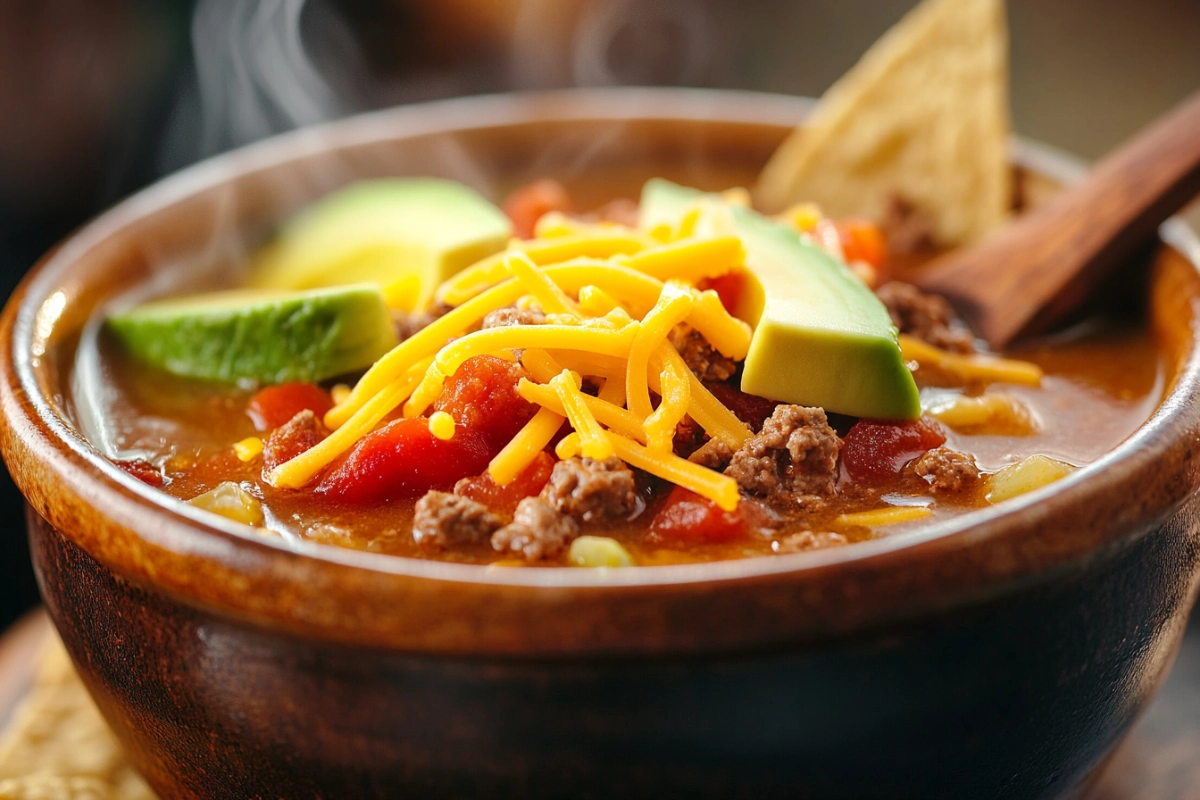A delicious taco soup should be hearty, rich, and full of bold flavors — not thin or watery. If you’ve ever asked yourself, “Why is my taco soup so watery?” you’re not alone. Many home cooks face this frustrating issue when trying to prepare a comforting bowl of taco soup. Fortunately, the problem is easy to fix once you understand the causes and solutions.
In this comprehensive guide, we’ll break down the common reasons behind a runny taco soup and how to fix them. From ingredient mistakes to the importance of proper ratios, you’ll learn how to create a thick, flavorful taco soup every time. Let’s dive in!
Understanding the Causes of Watery Taco Soup
Common Mistakes in Taco Soup Preparation
One of the most frequent reasons people ask, “Why is my taco soup so watery?” is due to simple mistakes during the cooking process. Adding too much liquid without balancing the other ingredients can dilute the entire dish.
Here are some common errors to avoid:
- Excess Liquid: Adding too much broth or water.
- Inaccurate Measuring: Eyeballing ingredients instead of measuring.
- Overcooking Vegetables: Some veggies, like tomatoes, release water as they cook.
- Skipping Thickening Agents: Forgetting ingredients like cornstarch, beans, or potatoes.
Pro Tip: Always aim for a balance between liquid and solid ingredients for the perfect soup consistency.
The Role of Ingredients in Soup Consistency
The choice of ingredients plays a huge role in determining how thick or watery your taco soup turns out. Some ingredients naturally retain more water, while others can help thicken the soup.
- Broth vs. Water: Using broth instead of plain water adds both thickness and flavor.
- Beans and Lentils: These legumes can act as natural thickeners when mashed.
- Tomatoes: Fresh tomatoes tend to release water, so consider using a tomato paste instead.
- Dairy Additions: Ingredients like cream or cheese can create a richer texture.
To prevent a watery soup, focus on balancing liquid ingredients with thickening components. If you’re using high-water-content veggies, cut back on added liquids or consider simmering longer.
Fixing Watery Taco Soup: Step-by-Step Guide
If you’ve ever asked, “Why is my taco soup so watery?”, you’re likely searching for a quick fix. Fortunately, there are several reliable methods to thicken your taco soup without compromising its bold, hearty flavors.
Thickening Agents: Cornstarch, Flour, and Roux
Adding a thickening agent is a foolproof way to fix watery taco soup. Here’s how you can use each method:
- Cornstarch Slurry: Mix 1 tablespoon of cornstarch with cold water, then stir it into the soup. Simmer for a few minutes until the soup thickens.
- Flour Slurry: Combine 1 tablespoon of flour with cold water, whisk well, and pour it into the soup while simmering.
- Roux Method: Cook equal parts butter and flour in a pan until golden, then stir it into the soup for a richer, creamier consistency.
For more natural options, mashing a portion of the beans or potatoes directly in the soup can work wonders.
Reducing Liquids Without Losing Flavor
Excess liquid is often the main culprit behind a runny soup. To balance the consistency:
- Simmer Without a Lid: Let the soup cook uncovered over low heat, allowing excess water to evaporate naturally.
- Use a Blender: Blend a small portion of the soup to create a thicker base while retaining texture.
- Add Thick Ingredients: Stir in ingredients like mashed beans, pureed vegetables, or tomato paste for natural thickening.
By balancing the soup’s liquid-to-solid ratio, you can transform watery taco soup into a satisfying meal with bold, spicy notes.
Adjusting Ingredients for Perfect Soup Consistency
Sometimes, the problem lies in the ingredients themselves. If you’re wondering, “Why is my taco soup so watery?” it may be time to adjust the core elements of your recipe.
Replacing Water with Broth or Stock
Water often dilutes the richness of taco soup. Instead, try using:
- Chicken broth: Adds both flavor and thickness.
- Vegetable stock: A great choice for vegetarian taco soup.
- Beef broth: Boosts the depth of flavor, especially in meaty versions.
Broths not only add thickness but also deepen the overall taste.

Balancing Vegetables, Proteins, and Liquids
A common issue is using too many watery vegetables without enough dense ingredients. To fix this:
- High-Water Veggies: Avoid excess tomatoes and zucchini. Use tomato paste instead.
- Protein: Ground beef, chicken, or turkey helps thicken the soup while enhancing its hearty nature.
- Beans and Lentils: Adding black beans, kidney beans, or lentils can bulk up your soup while absorbing excess moisture.
By fine-tuning these ingredients, you can achieve the perfect balance of flavor and thickness in your taco soup.
For more ways to keep your taco soup thick, you can check out how to thicken taco soup.
Enhancing the Flavor Profile Alongside Consistency
A watery taco soup doesn’t just lack thickness — it often misses out on bold, rich flavors. If you’re wondering, “Why is my taco soup so watery and bland?”, the problem might be with both texture and seasoning. Here’s how to thicken and flavor your taco soup simultaneously.
Adding Dairy or Fat for a Creamier Texture
Incorporating dairy products or healthy fats can solve both issues. These ingredients thicken the soup while enriching its taste:
- Cream Cheese: A small dollop melts smoothly into the soup, creating a rich, velvety finish.
- Heavy Cream: Adds thickness and a luxurious texture without overpowering the spices.
- Shredded Cheese: Stirring in cheddar or pepper jack cheese can make the soup creamier while boosting flavor.
Fats also help carry spices, making every bite more flavorful and satisfying.
Using Acidity and Seasonings to Enhance Flavors
When your taco soup tastes bland despite the right thickness, try enhancing the flavor with acidity and spices.
- Citrus Juice: A splash of lime juice adds brightness and balances the richness.
- Vinegar: Apple cider or red wine vinegar can enhance the savory notes.
- Spices: Don’t forget chili powder, cumin, and smoked paprika for authentic taco flavor.
Pro Tip: If you’re adding acidity, do so toward the end of cooking to preserve its punch.
Preventative Tips for Future Taco Soup Success
Preventing a watery taco soup starts with a few proactive kitchen habits. If you’ve ever asked yourself, “Why is my taco soup so watery?”, follow these tips next time you cook.
Measuring Ingredients Accurately
An imbalance of ingredients often leads to excess liquid. Stick to these guidelines:
- Use Measuring Cups: Always measure both liquid and solid ingredients for balance.
- Control Broth Quantity: If using broth, add it gradually rather than all at once.
- Monitor Water Content: Avoid water-rich vegetables unless they are balanced with thickening agents.
Consistency comes from the right ratios — not just the right ingredients.
The Role of Cooking Time and Heat Levels
How you cook your taco soup also affects its thickness. Key practices include:
- Simmer Uncovered: Cooking without a lid allows liquid to evaporate naturally.
- Low and Slow: Cooking on low heat for longer allows flavors to develop while reducing excess water.
- Avoid Overcooking: Too much heat can break down vegetables, releasing extra moisture.
By controlling these factors, you can create a thick, flavorful taco soup every time.
For more hearty soup ideas, check out how to thicken taco soup.
FAQs About Watery Taco Soup
If you’ve been wondering, “Why is my taco soup so watery?”, you’re not alone. Many home cooks face this issue. Here are the most common questions and their solutions to help you create a perfectly thick taco soup every time.
What Can I Use Instead of Cornstarch for Thickening?
Cornstarch is a popular thickener, but there are plenty of alternatives:
- Flour Slurry: Mix 1 tablespoon of flour with water and stir it into the soup.
- Mashed Beans: Blending a portion of the beans helps thicken the soup naturally.
- Potato Flakes: A small handful can absorb excess moisture and add texture.
- Arrowroot Powder: Similar to cornstarch, it works well in smaller quantities.
Tip: Always mix your thickener with cold water before adding it to avoid clumps.

Why Does My Soup Get Watery After Refrigerating?
Ever noticed your soup thinning out after a night in the fridge? That’s because some ingredients, like tomatoes and vegetables, release moisture over time.
Quick Fix:
- Reheat the soup and allow it to simmer uncovered to reduce excess liquid.
- Add a bit of cornstarch slurry or mash some beans to bring back thickness.
How Can I Avoid Overcooking My Taco Soup?
Overcooking vegetables can release more moisture, leading to a thinner soup.
Best Practices:
- Cook on low heat for a longer period instead of boiling on high heat.
- Keep a close eye on cooking times, especially with vegetables like zucchini and tomatoes.
What Are the Best Ingredients for Thickening Soups Naturally?
If you’re looking for natural ways to fix your watery taco soup, try:
- Sweet Potatoes: Adds both sweetness and body to the soup.
- Legumes: Black beans and lentils thicken while boosting protein.
- Dairy: Heavy cream, cream cheese, or cheddar cheese can create a rich, thick consistency.
Using LSI and NLP Keywords to Optimize Soup Recipes
In the world of food blogging, using related keywords is just as important as writing great content. If you’re creating recipe posts, incorporating LSI (Latent Semantic Indexing) and NLP (Natural Language Processing) keywords improves your search ranking.
Incorporating Thickening Techniques Into Other Soups
If you’ve figured out how to fix watery taco soup, why not apply the same tricks to other recipes?
- Chili and Stews: Thickening with beans, roux, or potatoes works just as well.
- Vegetable Soups: Simmering without a lid and blending a portion can help.
- Creamy Soups: Adding cream cheese or heavy cream enhances both texture and flavor.
Keyword Optimization for Soup Recipes
When writing a soup-related blog post, use the keyword “Why is my taco soup so watery?” naturally in headings and content.
LSI and NLP Keywords to Include:
- Thickening taco soup
- How to fix watery soup
- Soup consistency tips
- Cornstarch for soups
- Hearty taco soup
Tip: Use these phrases in different sections to boost visibility without keyword stuffing.
By following these SEO strategies and kitchen hacks, you can create the perfect taco soup while helping readers solve their cooking challenges.
Common Mistakes to Avoid When Making Taco Soup
If you’ve ever asked yourself, “Why is my taco soup so watery?”, you may be making one of these common mistakes. Thankfully, avoiding these errors can keep your soup thick, hearty, and delicious.
Adding Too Much Liquid Too Early
A frequent mistake is adding all the broth or water at the start. While it may seem harmless, excess liquid can make the soup too thin.
Solution:
- Start with a smaller amount of liquid and gradually add more as needed.
- Use broth instead of water to add both thickness and flavor.
Skipping Proper Ingredient Ratios
Taco soup relies on a balance between solids and liquids. Adding too many vegetables with high water content (like fresh tomatoes) without enough dense ingredients can lead to a watery mess.
Quick Fix:
- Use thicker ingredients like tomato paste instead of fresh tomatoes.
- Add hearty fillers like black beans, corn, or ground beef for better texture.
Overcooking Vegetables
Overcooking soft veggies can cause them to break down and release moisture, thinning the soup.
Preventative Tip:
- Add delicate vegetables towards the end of cooking.
- Use low heat for a slow simmer rather than boiling rapidly.
By keeping these mistakes in check, you’ll avoid a watery soup and enjoy a richer, more satisfying bowl every time.
How to Serve and Store Taco Soup Properly
Once you’ve solved the mystery of “Why is my taco soup so watery?”, it’s essential to know how to serve and store it correctly. Proper handling can make a difference in maintaining the ideal consistency.
Best Serving Practices for Thick Taco Soup
A well-thickened taco soup pairs beautifully with a variety of toppings and sides. Consider these serving suggestions:
- Toppings: Try shredded cheese, sour cream, avocado slices, and crushed tortilla chips for extra texture.
- Sides: Serve with cornbread, crusty bread, or a green salad to balance the richness.
- Presentation: Use bowls that retain heat well and keep the soup warm throughout the meal.
Storing and Reheating Taco Soup Without Losing Thickness
Taco soup often becomes watery when stored, but there are simple ways to keep it thick:
- Refrigeration: Store the soup in an airtight container for up to 4 days.
- Freezing: Freeze taco soup in portioned containers for up to 3 months.
- Reheating Tips: When reheating, simmer the soup gently on the stove without a lid. If needed, add a cornstarch slurry to restore thickness.
By following these steps, you can enjoy a perfectly thick taco soup every time you reheat it!

